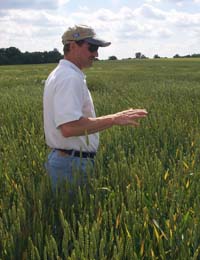Wheat Decisions 1999' Program Set September 14 in Henderson
Wheat Decisions 1999' Program Set September 14 in Henderson

Kentucky wheat producers likely will need to adjust some crop management practices at planting time this fall. Agricultural scientists will discuss how the summer drought and economic situation will affect wheat planting and marketing decisions at a "Wheat Decisions 1999" program September 14 at the Henderson County Cooperative Extension Service office.
The program will begin at 7:30 a.m. (CDT). It should conclude about 10:30 a.m.
"The combination of downward pressure on prices now and possibility of the drought continuing on into the fall makes it critical for producers to fine tune their management skills related to production," said Mike Smith Henderson County Extension agent for agriculture and natural resources.
‘Wheat Decisions 1999' is a comprehensive package of information to help producers make management adjustments that will increase production, as well as economic information to aid in decisions of whether wheat is a viable option for their operation this year given the weather and marketing potential," Smith added. "We also will address decisions producers need to make in a double-crop situation."
Smith said the morning program will benefit producers who've made a decision not to grow wheat this year because it will provide information that will be valuable to producers when wheat prices rebound.
Agricultural economists will discuss the wheat price outlook and implications for profit in Kentucky's 2000 year crop.
"In wheat production, it's always important to take soil tests prior to planting wheat in a two-year crop rotation. "But having soil test results is especially crucial because wheat producers are facing a difficult economic situation. In light of this situation, they will be better off using the more conservative fertilizer recommendations to cut input costs," said Lloyd Murdock, Extension agronomist at the University of Kentucky College of Agriculture's Research and Education Center in Princeton.
Because corn yields will be down due to the drought, producers planting wheat behind corn can take advantage of some nitrogen carryover in soil and won't need to fertilize with nitrogen in the fall.
Murdock advised producers who aren't already planting no-till to consider this practice.
"No-till wheat is a viable alternative to conventional, or tilled, wheat because it has similar yields and requires less time and effort and fewer inputs," he said. "Our research has shown that one long-term effect of a no-till system is increased yields of corn and soybeans planted in rotation with no-till."
"If it remains dry, producers might have to plant deeper than normal this fall to get adequate moisture for germination. However, planting seed too deeply has the potential to cause emergence problems. Hopefully, we'll have rainfall between now and October. We will need adequate soil moisture come October to get the germination and emergence needed for optimum stands.," said Jim Herbek, Extension agronomist at Princeton.
Herbek advised producers to base the seeding rate in terms of seeds per unit area, rather than by volume or weight per area. Seed size can vary by variety as well as seed lot. Variations in seed size can result in differences of 50 pounds or more per acre in the number of seed that need to be planted. Planting according to the number of seeds makes it easier to establish a stand with a uniform number of plants per acre regardless of the seed size.
"To arrive at the optimum seeding rate," Herbek said," calibrate your drill so it will dispense the number of seeds you want it to deliver. Proper calibration will save you money in the cost of seed because you won't be putting out more seed than necessary. It also will ensure that you put out enough seed to get a good stand."
Herbek said there will be a demonstration of the drill calibration procedure at the meeting.
It's important for producers to know what factors determine herbicide carryover and the impact this carryover has on wheat, according to Bill Witt, Extension agronomist in Lexington.
"Weather conditions are a major determinant in whether herbicides carryover," he said. "There's some concern about carryover from corn herbicides due to the drought. Another factor is the chemistry of the herbicide–how quickly it breaks down chemically and microbially ."
College of Agriculture scientists also will discuss results of variety trials and variety selection, seed treatment fungicides, weed and insect control, considering no-till wheat to enhance profits, and the economic outlook and marketing.
The Henderson County Cooperative Extension Service office is at 3341 Highway 351 East.
-30-
Sources: Mike Henderson (270) 826-8387
Steve Riggins (606) 257-7256
Jim Herbek (270) 365-7541, Ext. 205
Lloyd Murdock (270) 365-7541, Ext. 207
Bill Witt (606) 257-1823